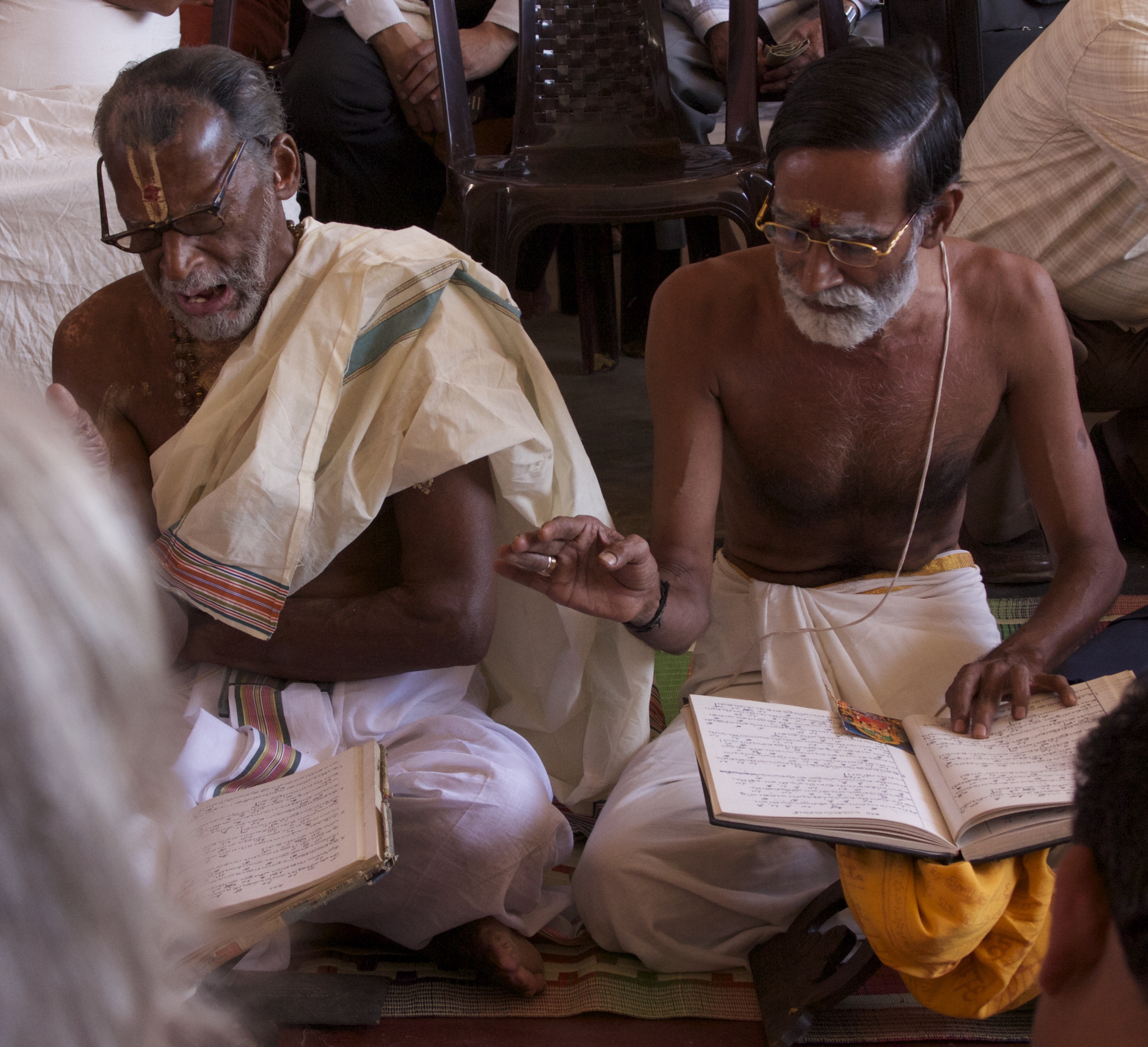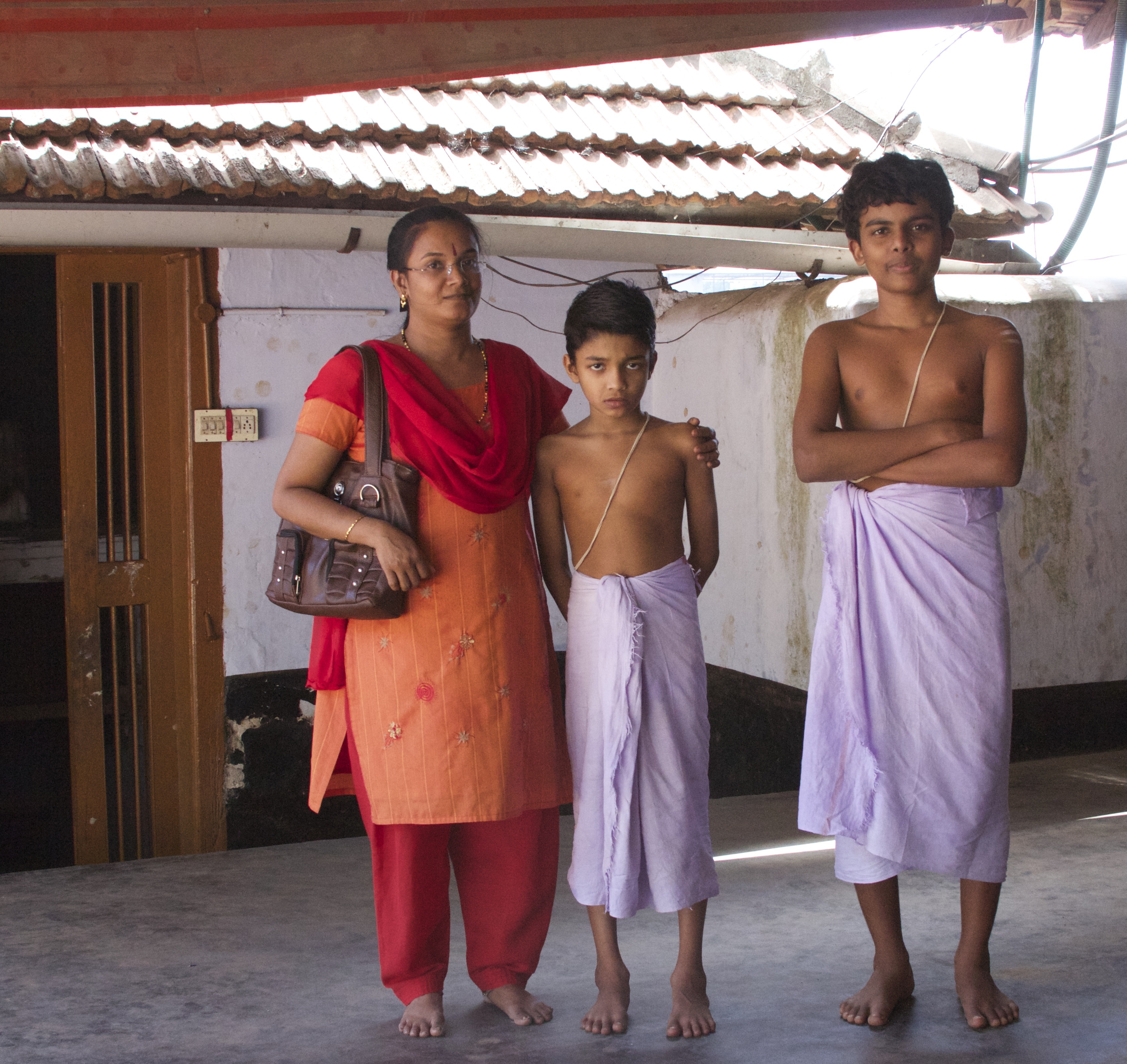Vedic chanting in Kerala
On 7 November 2003 the United Nations Educational, Scientific and Cultural Organization (UNESCO) declared the Tradition of Vedic Chanting (India) a Masterpiece of the Oral and Intangible Heritage of Humanity. According to Indian tradition, four Vedas – the Ṛgveda (hymns), the Yajurveda (sacrificial formulas), the Sāmaveda (chants) and the Atharvaveda (magical formulas) – are considered to be nonhuman in origin (apaurus·eya), beginningless (anādi) and eternal (nitya). This awareness prompted Brahmins of India to create unique methods for their preservation and transmission without even changing any of the accents. These methods are based on sophisticated mnemonic techniques and rely on different versions of repetitions.
Along with the two main powerful Vedic traditions (the Western tradition: Maharashtra, Saurashtra, Varanasi – and the Southern tradition: Tamil Nadu, Andhra Pradesh, Mysore) several isolated traditions have also survived: White Yajurveda tradition in Tamil Nadu; the rare Atharvaveda tradition of the Śaunaka recension in Saurashtra; the Paippalāda recension in Orissa; and the tradition of Malayalam-speaking Nambudiri Brahmins in Kerala.
The Nambudiri (Nampūtiri, Namboodiri, Namboothiri) tradition is rather different from other traditions. The Vedic recensions that Nambudiris follow are considered to be more ancient than other surviving versions, most of them not found anywhere else in India.1 The ways in which the Nambudiris have preserved their Veda recitations, through their unique mnemonic techniques, have managed to conserve a number of distinctive and ancient features. It is a relatively small, but self-sufficient tradition, as it does not require officiating priests from elsewhere when rituals require several kind of priests.2 Professor J.F. Staal studied this unique tradition profoundly and presented it in numerous works, including the outstanding Agnicayana Project – a unique documentary of the twelve-day Vedic śrauta ritual performed by Nambudiri Brahmins in 1975. A detailed illustrated description of this ritual was published in two massive volumes with audio and video recordings and the articles of leading scholars on the subject.3 In 1999 the Calicut (Kozhikode)-based voluntary non-profit-oriented forum of Nambudiris launched the website: www.namboothiri.com. The 750-page site, with the objective of documenting Nambudiri traditions, is administered by Dr P. Vinod Bhattathiripad4 and has members from all over the world.
The Nambudiri Brahmins of Kerala
Kerala is the region of Malayalam-speaking people in the southwest of India, on the Malabar coast. The Western Ghats formed a natural barrier to contacts from the rest of India and created the conditions for developing a unique culture, which preserved many archaic elements, while developing or adapting customs and rituals its own way.
The Nambudiri Brahmins of Kerala are rather small in number; they are still isolated from other Brahmins of India and differ from them in a number of customs, including marriage rituals, and their sense of purity and pollution. The Nambudiri Brahmins observe unique orthodox religious practices and have an influence over the social life and culture of the Malayāl ˙ īs (citizens of Kerala). The majority of Nambudiri Brahmins live in the countryside, outside the villages, and are considered refined and aristocratic, connoisseurs of literature, music and traditional arts.5 Their peculiar system of inheritance determined, until 1933, that the eldest son inherited all family property and could only marry a woman of his own caste. This ruling worked to preserve the Nambudiri distribution of land (keeping it undivided); living as landed aristocracy left them more time for rituals, literature, and the arts.
Not all Nambudiri Brahmins were required to follow Vedic studies. Out of the ten Nambudiri classes (Aadu, Edu, Bhiksha, Picha, Othu, Saanthi, Adukkala, Arangu, Panthi, Kadavu), only the first five needed to memorise Veda and learn Vedic chanting, while the other five were exempted from Vedas for the purpose of attaining other skills. For instance, the Cāttira Nambudiris (or to be clearer Adukkala and Arangu classes) engaged in military training and studied the use of weapons. The As· ṭavaidyas – physicians (belonging to the Panthi class) – specialised in Ayurvedic medicine and studied the medical manual As·ṭāṅgahṛdaya of Vāgbhaṭa.
The Nambudiri tradition of Vedic recitations, their rituals, mnemonic techniques, and so forth, form an uninterrupted living tradition, handed down orally from father to son, from teacher to student. As a living tradition, it demonstrates the differences between tradition and texts.6
In danger of extinction
The Nambudiri Sāmaveda (chanting) tradition in Kerala is nearly extinct. There are now only four elderly Nambudiri Brahmins from two families who have learned Sāmaveda by heart the traditional way, and who can chant all the modes followed in Kerala: Ṛk (in Kerala it is called Ārcika), Sāma (or Grāmageya), Candrāsyāma (or Āraṇyaka), Ūha and Ūsāṇi.7
In light of the danger that after these rather old Nambudiri Brahmins the Nambudiri’s Sāmaveda chanting tradition of Kerala will become extinct, the School of Vedic Studies at the Sree Sankaracharya University of Sanskrit (in Kalady) has undertaken and successfully completed a project to preserve the Kerala Sāmaveda tradition in 95 hours of audio/video documentation. The entire project has been published on CDs and is available for study and reference from the University Library. Another project proposes to convert recordings into interactive CDs – the text in Sanskrit with English translation, transliteration, graphics and index of the Mantras.8
The Nambudiri Sāmaveda tradition in Kerala is of the Jaiminīya recension. This recension is also followed by Tamil Brahmins, originating from the neighbouring state of Tamil Nadu, but who re-located to Kerala long ago. Their village Kodunthirapully near Palakkad on Kerala’s border with Tamil Nadu is a typical ancient Tamil Brahmin settlement (agrahāra). Most of these Tamil Brahmins use handwritten copybooks with the Sāmaveda text in Malayalam script.

Tamil Brahmins from village Kodunthirapully near Palakkad.
Schooling
The Nambudiri Ṛgveda tradition in Kerala has two schools, which differ only in a small number of mantras and syllables in some modifications of repetitions (vikṛtis). Each school had its own training centre (maṭham), one at the heart of Thrissur town and the other in the village of Thirunaavaaya on the banks of river Nila. The Thrissur maṭham is active; children learn Vedic chanting at this school. The Thirunaavaaya maṭham is not active; member families initiate their children into Vedic chanting in their own homes or send them to the Thrissur maṭham where they are trained in the Thirunaavaaya school style.
In early times Nambudiri boys began the study of reciting the Veda with saṃhitā-pāṭha 9 at home and were only admitted to the Brahmasvam maṭham for learning higher modes of chanting. However, with the weakening of the tradition almost all learning processes have moved into the Trissur Brahmasvam maṭham. Moreover, if previously only the Ṛgveda (hymn) recitation was studied here, now the traditional training extends to the Yajurveda (sacrificial formulas) and the Sāmaveda (chanting). The students begin their traditional study at the age of seven or eight and for four years are taught the complete saṃhitā-pāṭha, studying from early morning to evening. Then they are admitted to general school and alongside modern education continue their traditional Vedic learning in the mornings, evenings and holidays. They study pada-pāṭha, krama-pāṭha and other higher modes of chanting that are practised in Kerala, namely jaṭā-pāṭha and rathā-pāṭha, which take another 12–15 years.10
During the period of Vedic study students must undergo rigorous activities and observe many strict rules. They bathe early in the morning and in the evening; in the morning they practise Sūrya Namaskāra or Sun Salutations, etc. In addition to the austerities, a number of particular vows are taken. Some vows can last up to a year, during which time the pupil has to restrict even his daily food. These austerities are common to all the Vedas.11
The techniques
To memorise so much information – more than 10,500 mantras and different modes, with accents and tones – Nambudiri Brahmins have used different methods from ancient times, most of which were transmitted orally in Malayalam and Sanskrit. Some of them were published in Malayalam; some exist in manuscript form. In 2010, the Sree Sankaracharya Sanskrit University in Kalady published some of them in Sanskrit, in addition to several previously unpublished treatises, in the book Preservation Techniques of the Ṛgveda Chanting of Kerala.
At the beginning of a pupil’s training (during the first six months), the accents are taught by an unusual method. The teacher physically moves the pupil’s head with his right hand, in the following way: head straight – the udātta (raised accent, accented syllable), downward – the anudātta (syllable preceding the udātta, not-raised, not-accented), head to the right – the svarita (syllable following the udātta, sounding), to the left – the pracaya (‘accumulated’ accent). [See video 1]
The class always begins with the recitation of the sacred syllable Om by the teacher, followed by the students. During the next stage of the training the accents are stressed by placing the hands into particular positions (mudras): the hand up – the udātta, down – the anudātta, to the right – the svarita, to the left – the pracaya. [See video 2]
For the Ṛgveda recitation and the chanting of the Sāmaveda, Nambudiris use two sets of mudras or hand gestures. The Ṛgvedic mudras, besides stressing the accents, are used to indicate the ends of words of the pada-pāṭha or ‘word-for-word’ recitation, which clarifies obscure places in the text. The Sāmavedic mudras represent musical accents and phrases and are used less than the Ṛgvedic mudras.
Pupils learn the saṃhitā-pāṭha and the pada-pāṭha without knowing Sanskrit grammar or the rules of sandhi12 – they learn these rules through practice involving the body. It should be noted that oral memory has a high somatic component and from all periods of time, across cultures, we have indications that traditional composition has been associated with hand activity.13 According to Indian tradition, an endless mechanical repetition provides error-free memorisation.
The Nambudiris also follow unique techniques, which differ from mnemonic techniques elsewhere in India. Some of them are practised at traditional contests in the ceremonial chanting of the Ṛgveda (as Kadavallur Anyonyam in Sri Ramaswamy Temple at Kadavallur, Trissur District) and in various rituals. One traditional technique is called vāram. In this ‘exercise’, Nambudiris show their mastery of dividing the Ṛgveda text into asṭakas, adhyāyas and vargas,14 their mastery of mudras, and mastery of reciting by heart the Vedic passages. During the vāram two participants randomly choose a ten ṛks sequence using twelve small stones placed in an eight stone circle with four stones inside the circle. One participant touches a stone in the outer circle; another participant then, without looking, touches a different stone in the same circle. By counting from the first to the second stone, they achieve the number of asṭaka. In the same way they choose adhyāyas. The vargas are chosen from the stones inside the circle. The third Nambudiri recites the chosen sequence of ṛks. [See video 3]

Two students of the Trissur Brahmasvam Matham (the younger with his mother)
Scholars of the Veda
As was stated at the beginning of the article, according to Indian tradition, the Vedas are non-human in origin, beginningless and eternal; this means that people could never hope to understand them fully. Perhaps this is the reason that, along with the oral tradition of preserving and transmitting the sounds of the Vedas, there has been no similar tradition of preserving and transmitting the meaning of the Vedas. Over time, the meaning of the ancient Vedic language has been partially lost. The interpretation of the Vedas developed another great intellectual tradition that has influenced all Indian culture. But, as pointed out by Frits Staal, the main purpose of reciting and repeating the Vedas is their preservation and transmission – not studying or researching – and without this “scholars of the Vedas would have nothing to be scholars of.”15
Natalia Korneeva, independent research scholar, Moscow. natankor@gmail.com.
All photos and videos in this article were taken in traditional Brahmin villages in Kerala visited during the cultural tour following the 6th International Vedic Workshop (January 2014, Kozhikode).